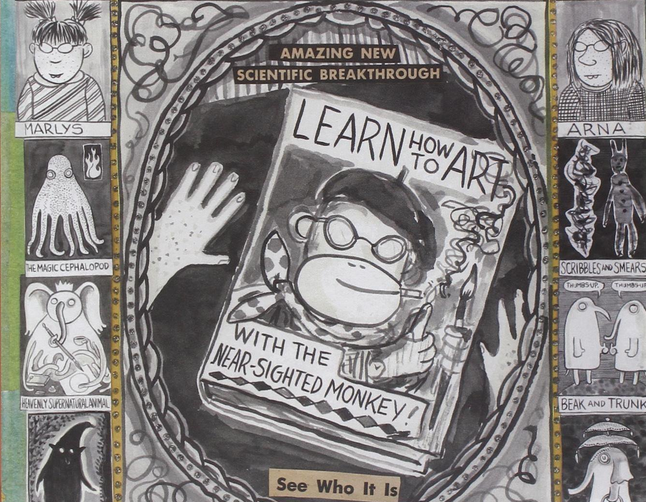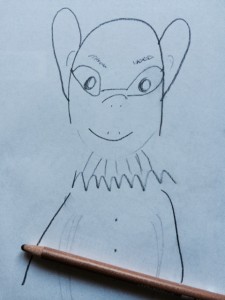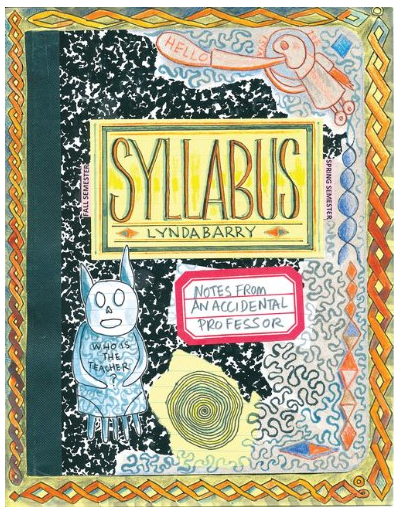 Actually, Lynda Barry doesn’t write or draw at all about leadership.
Actually, Lynda Barry doesn’t write or draw at all about leadership.
She’s an award-winning cartoonist, known for her comic strip “Ernie Pook’s Comeek,” which ran in alternative newspapers for 30 years. She draws funny pictures of herself. She teaches. And she’s created a cartoon alter-ego: a nearsighted monkey who smokes from a pack of cigarettes called “Don’t.”
Her recent graphic book: Syllabus: Notes from an Accidental Professor contains curriculum notes from a class she taught at the University of Wisconsin called The Unthinkable Mind. The book is full of her ideas, cartoons, sketches, and the course syllabus along with drawings from her students, all crammed into a composition book – the lined notebooks with black marbled covers some of us used in school.
Look out: if you read her book your own creative urges may start rumbling and the humble composition book will never look the same.
Lynda guides her students to find images in the ordinary that are interesting, unique, evocative, and often seem to emerge almost accidentally.
Her students transform their composition books into treasure chests of doodles, stories, sketches, and colorings embellished with additions like movie stubs, receipts, memories, dreams, things they said, things they wished they said, rants, photos, and more.
Their drawings made me smile and want to play visually again. But then I remembered: visual art (like drawing and painting) is NOT my forte!
I officially abandoned drawing after poor reviews in the third grade.
Reading Lynda Barry is like sneaking back into a world where art is allowed to flourish without the harsh judgments I remember experiencing and often inflict on myself. I felt like a camel poking her nose under the tent into the classroom, watching the fun, and wondering, “Maybe I could learn here, too?”
She writes: “I’m especially interested in people who quit drawing a long time ago. I have a theory I’m trying to work out about bringing drawing back into someone’s life which is different than teaching them to draw…I’m interested in using the drawing that is already there – is still there in spite of everything.”
Personal note: after my Father died, I discovered a box of his art supplies, waiting to be given away. I took them home. He loved to draw and paint, just for himself, after he retired from his corporate job. And even though I had shown no aptitude for drawing, painting or pastels, I looked at his supplies and thought. “No, I’m not letting these go. Even if I only use them to play – these supplies are part of who I am, too.”
I have a hunch that she’s sneaky and is up to something bigger than she describes. Drawing, sketching, doodling, stories, etc. are the vehicle she’s using – the toolbox she offers.
But I think she’s offering us a way to see again – to open the dormant imagination that is still in there, somewhere.
(And isn’t that part of the job of leaders – to ignite creativity and innovation?)
She obviously takes play seriously. Her students can’t be late, or cut classes (it will cost their grades), and she says she insists that they call her “Professor” (that from a woman who draws weird chickens, gremlins, and smoking monkeys!) She demands performance without making her students compete against each other. A student who wants an “A” in her class, has to work super hard, engage, and find something original during the course of the semester (a quality she doesn’t define but says everyone knows it when they feel it.)
She’d never fit at Microsoft where team member used to be rated against each other.
Lynda opens the door to having her students pay attention to the curious, the unexpected, and the details in their worlds. They carry their notebooks everywhere and practice “being present and seeing what’s there” a phrase she quotes from Marilyn Fraca, her teacher from her Evergreen State College days.
Her students work hard. Armed with a composition book, a pen, pencil, glue and the original digital device, a pair of hands, they draw, they color, they write, they copy cartoons made by others, they ink, and they make collages. They also memorize and recite an Emily Dickinson poem. They are encouraged to dance. They spend long periods of time drawing spirals and coloring (which sounds awfully like meditation to me).
They experience timelessness and they meet deadlines.
They invent and they see. I bet they laugh.
Syllabus is full of drawings from students who thought they couldn’t draw. Sure, her student’s primitive but totally fetching sketch of “Batman” looks a little like “Catman” but maybe that’s the point. It’s original and appealing!
Her students are told not compare themselves to their classmates or, like some of us, begin evaluating and censoring our work before we’ve even begun.
In contrast, they discover the little miracles that happen when they reject labels like “I’m bad (or good) at something.”
After reading her book, I want to be awake to the small, quirky, interesting moments that happen on my otherwise routine days.
Lynda Barry doesn’t write on leadership. But I bet if you read her book, you’ll discover ways to stimulate both your creativity and innovation. Because rather than tell us all the principles that guide her work, Lynda offers us a chance to have our own experiences and insights – while keeping our hands moving.
So today, rather than summarizing leadership principles (yawn), I’ll just encourage us both to experiment.
After reading Lynda’s book, maybe I’ll just unplug from my computer, take a pencil, and let my imagination reboot.
(Top two pictures from the covers of Picture This! and Syllabus. Doodle by SF)











One Response
This is really about finding one’s voice and then being true to it. And I think that that leads to authenticity, which is, of course, what we are ultimately judged by.
As an avocation, I write and “do art.” I have learned over the years that the more I work at it the “better” I get. Will I ever be a Hemmingway or a Picasso? Not in this lifetime. Will I ever be a great academic? Not in this lifetime. But I will become increasingly authentic, speaking and sharing my truth in ways that I hope ease the journey for others. Maybe that’s enough.
In the end, when I stand before my Maker, I do not think he is going to ask me about my professional life or my avocations. He (if indeed he is a “he” will ask me only two questions; What did you learn? How much did you love? I will show Her/him my “doddles” in response to the first question. In response to the second, if I am authentic, I must answer, “Not enough.”